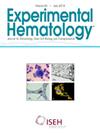Effect of peritransplant measurable residual disease clearance in patients with myelodysplastic neoplasm: a referral center experience
IF 2.1
4区 医学
Q2 HEMATOLOGY
引用次数: 0
Abstract
Pre-allogeneic stem cell transplant (pre-HSCT) measurable residual disease (MRD) is increasingly recognized as a prognostic marker. However, the MRD status in myelodysplastic neoplasm (MDS) or myelodysplastic/myeloproliferative neoplasm (MDS/MPN) are less well-defined. We performed a retrospective chart review of adults who underwent HSCT for MDS or MDS/MPN in 2012-2023 and evaluated the effect of pre-HSCT MRD status on relapse-free survival (RFS) and overall survival (OS). A conditional analysis of outcomes based on day+90 post-HSCT MRD status was also performed. There were 38 and 55 patients in MRD− and MRD+ cohorts respectively. Baseline patient characteristics, including age, Revised and Molecular International Prognostic Scores (IPSS-R and IPSS-M), and HSCT-related factors were similar between cohorts. The MRD+ cohort had inferior RFS (HR: 1.84, 95% CI: 1.09–3.12, p = 0.02) but a statistically significant difference in OS was not evidenced (HR: 1.52, 95% CI: 0.88–2.61, p = 0.14). After adjusting for % blasts at diagnosis, and conditioning intensity, patients in MRD+ cohort were 1.92 times at increased risk of relapse or death (95% CI: 1.12–3.28, p = 0.02). Additionally, increasing IPSS-M score was associated with poorer RFS (HR: 1.27, 95% CI: 1.01–1.59, p = 0.04) and OS (HR: 1.52, 95% CI: 1.20–1.91, p < 0.01). Among patients who were alive and in remission until day +90 post-HSCT, the pre-HSCT MRD status did not confer a statistically significant difference in RFS and OS if they became MRD− by day +90 post-HSCT. Post-HSCT MRD surveillance should be performed routinely in MDS patients.
骨髓增生异常肿瘤患者移植期可测量残留疾病清除率的影响转诊中心经验:MDS患者hsct周MRD清除的影响。
周围异体干细胞移植(hsct)可测量残留病(MRD)越来越被认为是一种预后标志物。然而,与b急性淋巴母细胞白血病相比,骨髓增生异常肿瘤(MDS)或骨髓增生异常/骨髓增生性肿瘤(MDS/MPN)的MRD状态尚不明确。我们回顾了2012-2023年间因MDS或MDS/MPN接受HSCT的成年人的图表,并评估了HSCT前MRD状态对无复发和总生存期(RFS和OS)的影响。基于hsct后90天MRD状态的结果也进行了条件分析。MRD-组和MRD+组分别有38例和55例患者。基线患者特征,包括年龄,修订和分子国际预后评分(IPSS-R和IPSS-M),以及hsct相关因素在MRD+和MRD-队列之间相似。MRD+组的RFS较差(HR: 1.84, 95% CI: 1.09-3.12, p=0.02),但OS差异无统计学意义(HR: 1.52, 95% CI: 0.88-2.61, p=0.14)。在调整诊断时的爆炸率和调节强度后,MRD+患者复发或死亡的风险增加了1.92倍(95% CI: 1.12-3.28, p=0.02)。此外,IPSS-M评分增加与较差的RFS (HR: 1.27, 95% CI: 1.01-1.59, p=0.04)和OS (HR: 1.52, 95% CI: 1.20-1.91, p=0.04)相关
本文章由计算机程序翻译,如有差异,请以英文原文为准。
求助全文
约1分钟内获得全文
求助全文
来源期刊

Experimental hematology
医学-血液学
CiteScore
5.30
自引率
0.00%
发文量
84
审稿时长
58 days
期刊介绍:
Experimental Hematology publishes new findings, methodologies, reviews and perspectives in all areas of hematology and immune cell formation on a monthly basis that may include Special Issues on particular topics of current interest. The overall goal is to report new insights into how normal blood cells are produced, how their production is normally regulated, mechanisms that contribute to hematological diseases and new approaches to their treatment. Specific topics may include relevant developmental and aging processes, stem cell biology, analyses of intrinsic and extrinsic regulatory mechanisms, in vitro behavior of primary cells, clonal tracking, molecular and omics analyses, metabolism, epigenetics, bioengineering approaches, studies in model organisms, novel clinical observations, transplantation biology and new therapeutic avenues.
 求助内容:
求助内容: 应助结果提醒方式:
应助结果提醒方式:


